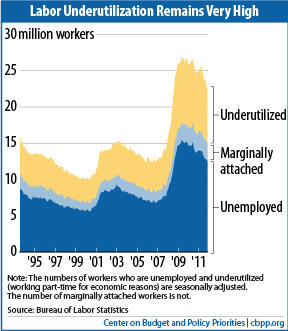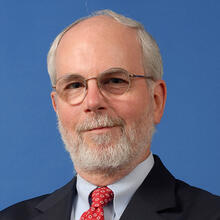Statement: Chad Stone, Chief Economist, on the April Employment Report
Today’s employment report shows that April’s job growth was disappointing for the second straight month and that the economic costs in terms of fewer jobs, less income, and lower growth remain very high. In particular, the number of workers in the Labor Department’s broadest measure of labor market underutilization — comprising the unemployed, discouraged workers and others “marginally attached” to the labor force who nonetheless have indicated they want to work, and people working part-time for economic reasons — stands at roughly 23 million. That’s much higher than at the start of the recession or, before that, than any time for which we have available data, dating back to 1994 (see chart).
The March and April employment numbers seem to bear out fears that the pickup in job gains of January and February may have been boosted more by favorable weather conditions than by a fundamental strengthening of the economic recovery. Last week’s preliminary estimate that the economy grew at a modest 2.2 percent annual rate in the first quarter, together with expectations of continued slow growth this year, indicate that a robust jobs recovery remains elusive.
The economy is operating well below its full productive capacity, with a substantial shortfall in jobs, production, and income. And, as the Congressional Budget Office (CBO) notes, the costs “fall disproportionately on people who lose their jobs, who are displaced from their homes, or who own businesses that fail.”

Though unemployed and underemployed workers bear the brunt of a long economic slump like the one we‘re experiencing, the economy’s long-term growth prospects are hurt as well. That should weigh more heavily than it apparently does in policymakers’ deliberations over how quickly to reduce budget deficits and how to achieve the Federal Reserve’s dual mandate to keep inflation in check (it is right now) and to promote strong economic growth and employment (both of which are weak).
About the April Jobs Report
Job growth was disappointing in April and it remains very difficult to find a job.
- Private and government payrolls combined rose by 115,000 jobs in April. Private employers added 130,000 jobs, while government employment fell by 15,000. Federal employment fell by 4,000 and local government employment fell by 12,000; state government employment rose by 1,000.
- This is the 26th straight month of private-sector job creation, with payrolls growing by 4.2 million jobs (a pace of 163,000 jobs a month) since February 2010; total nonfarm employment (private plus government jobs) has grown by 3.7 million jobs over the same period, or 144,000 a month. The loss of 502,000 government jobs over this period was dominated by a loss of 377,000 local government jobs.
- Despite the 26 months of private-sector job growth, there were still 5.0 million fewer jobs on nonfarm payrolls in April than when the recession began in December 2007 and 4.6 million fewer jobs on private payrolls. Payroll job growth in March and April took disappointing steps backward from the pace of job creation in January and February, and we remain well short of the sustained growth of 200,000 to 300,000 jobs a month or more that is typical of a robust jobs recovery.
- The unemployment rate edged down to 8.1 percent in April, and the number of unemployed Americans dropped slightly to 12.5 million. The unemployment rate was 7.4 percent for whites (3.0 percentage points higher than at the start of the recession), 13.0 percent for African Americans (4.0 percentage points higher than at the start of the recession), and 10.3 percent for Hispanics or Latinos (4.0 percentage points higher than at the start of the recession).
- The recession and lack of job opportunities drove many people out of the labor force, and we have yet to see a sustained return to labor force participation (people aged 16 and over working or actively looking for work) that would mark a strong jobs recovery. The decline in the labor force in April was discouraging. The number of people with a job fell by 169,000 and the number of people looking for a job fell by 173,000, for a total decline in the labor force of 342,000 people. The labor force participation rate edged down to 63.6 percent — its lowest level since 1981.
- The share of the population with a job, which plummeted in the recession from 62.7 percent in December 2007 to levels last seen in the mid-1980s and has been below 60 percent since early 2009, edged down to 58.4 percent in April.
- The Labor Department's most comprehensive alternative unemployment rate measure — which includes people who want to work but are discouraged from looking (those marginally attached to the labor force) and people working part time because they can't find full-time jobs — was 14.5 percent in April, down from its all-time high of 17.4 percent in October 2009 in data that go back to 1994, but still 5.7 percentage points higher than at the start of the recession. By that measure, almost 23 million people are unemployed or underemployed.
- Long-term unemployment remains a significant concern. Over two-fifths (41.3 percent) of the 12.5 million people who are unemployed — 5.1 million people — have been looking for work for 27 weeks or longer. These long-term unemployed represent 3.3 percent of the labor force. Before this recession, the previous highs for these statistics over the past six decades were 26.0 percent and 2.6 percent, respectively, in June 1983.
The Center on Budget and Policy Priorities is a nonprofit, nonpartisan research organization and policy institute that conducts research and analysis on a range of government policies and programs. It is supported primarily by foundation grants.
